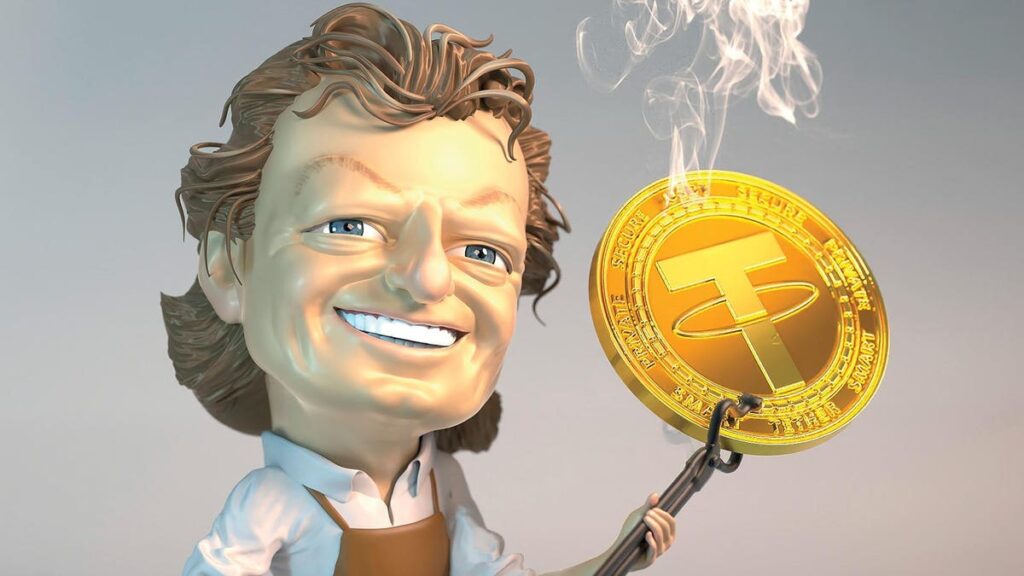This story appears in the August/September 2023 issue of Forbes Magazine. Subscribe
Members of the secretive management team behind $83 billion worth of Tether stablecoin have literally minted their own fortunes.
By Steven Ehrlich and Nina Bambysheva, Forbes Staff
Crypto is struggling. Under attack from regulators, the overall value of cryptocurrencies is down approximately 60% from its 2021 highs. But one digital asset company is thriving: stablecoin maker Tether. The secretive British Virgin Islands–based outfit has created a digital dollar with an $83 billion market value, up from about $65 billion just a year ago. In the first three months of 2023, Tether, which is responsible for more than 50% of the entire crypto market’s liquidity, says it posted a $1.5 billion profit.
It employs a simple, low-risk profitmaking model: Customers give the company U.S. dollars in exchange for a blockchain-based token it mints known as USDT (the “T” stands for Tether). Tether holds collateral mostly in the form of Treasury bills, money market funds, bitcoin and secured loans, and earns a market return on these “reserves.” USDTs are always supposed to be redeemable for $1 (ostensibly putting the “stable” in stablecoin) and redeemable on-demand, but Tether customers receive no interest on their holdings.
In March Tether benefited from the collapse of Silicon Valley Bank after it was revealed that its biggest competitor, Boston-based Circle, held more than $3 billion in uninsured deposits at SVB. Circle’s dollar-pegged stablecoin briefly dropped to as low as 88 cents—far enough to send nearly $10 billion worth of assets fleeing to Tether.
USDC’s Pain Was USDT’s Gain
Circle’s USDC saw $10 billion in outflows because of exposure to Silicon Valley Bank. Much of it went to Tether’s USDT.
Given its resilience and market dominance, Forbes estimates that the company—if its financials are indeed what it claims—might fetch as much as $9 billion if sold. That’s enough to make its top four executives billionaires. By Forbes’ calculations, chief financial officer Giancarlo Devasini owns more than 40%, a stake worth $4 billion.
Devasini, the company’s mastermind according to multiple sources, seems an unlikely crypto billionaire. His official biography on the Bitfinex website (Tether’s sister crypto exchange) paints the picture of a successful pioneer in the semiconductors market, whose business grew to 113 million euros in revenues annually before he sold it shortly before the 2008 financial crisis.
But a July 2021 Financial Times investigation found that in 2007, Devasini’s business empire had just 12 million euros in sales and went into liquidation the following June. Additionally, a Devasini company called Acme was the subject of a patent infringement suit brought by Toshiba over DVD format specifications. (Tether says the lawsuit was meritless and resulted in no adverse finding.)
Meanwhile, Tether CEO Jan Ludovicus van der Velde operates as more of a figurehead responsible for maintaining high-level strategic relationships with banks and regulators. Both Devasini and Van der Velde like to stay in the background and let Paolo Ardoino, the chief technology officer, serve as the company’s public face. Van der Velde and Ardoino each hold shares worth $1.8 billion. The company’s general counsel, Stuart Hoegner, has a stake worth $1.2 billion. Tether did not respond to a request for comment.
The company is riding high now, but if Congress passes stablecoin regulations, as the European Union did in May, it could give a leg up to a more compliant Circle, or to new entrants like banks. “Typically regulation entrenches incumbents, but that may not be the case here. If it becomes profitable to have a stablecoin, why wouldn’t banks enter that space?” says one Democratic congressperson who requested anonymity.
Another headwind could stir if USDT holders start demanding money market returns, which right now are between 4-5%. Forbes has learned of at least one U.S. company looking to create a regulated stablecoin that would pay money-market-esque returns starting this year. When Tether kicked the money-printing machine back into overdrive during the covid-driven boom, yields were close to 0%. It is a different world now. Tether’s founders have gotten rich on a free lunch served up by its customers. At some point the bill may come due.
MORE FROM FORBES
Read the full article here













